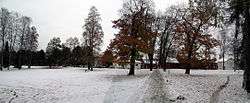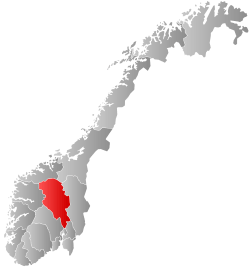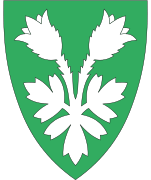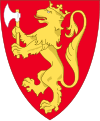Gjøvik
| Gjøvik kommune | |||
|---|---|---|---|
| Municipality | |||
|
Central Gjøvik | |||
| |||
 Gjøvik within Oppland | |||
| Coordinates: 60°47′36.3″N 10°41′42.9″E / 60.793417°N 10.695250°ECoordinates: 60°47′36.3″N 10°41′42.9″E / 60.793417°N 10.695250°E | |||
| Country | Norway | ||
| County | Oppland | ||
| District | Vest-Oppland | ||
| Administrative centre | Gjøvik | ||
| Government | |||
| • Mayor (2014) | Bjørn Iddberg | ||
| Area | |||
| • Total | 672 km2 (259 sq mi) | ||
| • Land | 630 km2 (240 sq mi) | ||
| Area rank | #165 in Norway | ||
| Population (2014) | |||
| • Total | 30,063 | ||
| • Rank | #28 in Norway | ||
| • Density | 44/km2 (110/sq mi) | ||
| • Change (10 years) | 2.8% | ||
| Demonym(s) |
Gjøvikenser Gjøvikensar[1] | ||
| Time zone | UTC+01:00 (CET) | ||
| • Summer (DST) | UTC+02:00 (CEST) | ||
| ISO 3166 code | NO-0502 | ||
| Official language form | Bokmål | ||
| Website |
www | ||
![]()
In 1861, the village of Gjøvik in the municipality of Vardal was granted town status and was separated from Vardal to form a separate municipality. On 1 January 1964, the neighboring rural municipalities of Biri, Snertingdal, and Vardal were all merged into the municipality of Gjøvik.
Etymology
The town is named after the old Gjøvik farm (Old Norse: Djúpvík), consisting of the elements djúpr "deep" and vík "inlet".[2]
Coat of arms
The coat of arms were granted on 2 September 1960. The arms show a white swan (Cygnus cygnus).
The former coat of arms, adopted in 1922, was a linden tree, with the statement Vis et voluntas (meaning "Force and will") on the lower part of the shield. The following design was a so-called "potpourri" vase, the most significant design of the glassworks that was the funding industry of the town.[3]
Demographics
| Ancestry | Number |
|---|---|
| 439 | |
| 283 | |
| 243 | |
| 197 | |
| 194 | |
| 178 | |
| 171 | |
| 156 | |
| 143 | |
| 125 | |
| 114 | |
| 106 |
Geography
Along with Hamar, Lillehammer, Brumunddal and Moelv, Gjøvik is one of the many towns bordering Norway's biggest lake, Mjøsa. The town administration of Gjøvik also covers the suburb area Hunndalen and the rural districts of Biri, Snertingdal, and Vardal. The municipal population is 28,807 (2010). About 16,000 people live in the urban area proper.
Gjøvik is bordered on the north by Lillehammer municipality, in the south by Østre Toten and Vestre Toten, and in the west by Søndre Land and Nordre Land. Across Lake Mjøsa to the east lies Ringsaker municipality in Hedmark.
The highest point is Ringsrudåsen with a height of 842 metres (2,762 ft).
Economy

Gjøvik owes much of its early growth to the local glassworks, which were established there by Caspar Kauffeldt in 1807. In the early 19th century, there was considerable immigration there from Valdres and Western Norway, aiding Gjøvik's growth. It was granted a town charter in 1861. Later, O. Mustad & Son became one of the world's largest manufacturers of fish hooks.[5]
Today Hoff Potetindustrier, Hunton Fiber and Natre Vinduer are some of the industrial companies operating from Gjøvik. The town is also a port for the former traffic ship, Skibladner, which is now a tourist ship.
The local paper is the Oppland Arbeiderblad. It was formerly a Labour Party newspaper. Defunct newspapers include Oplændingen and Velgeren (Labour Democrat/Liberal), Samhold (Liberal, later Agrarian) and Ny Dag (Communist).
Gjøvik has two notable hotels, the Grand hotel and the Strand hotel.
There have been three notable concerts held in Gjøvik's history, which starred Toto, Robbie Williams and Bryan Adams (June 2011).

Gjøvik Church
Gjøvik Church (Gjøvik kirke) was designed by architect Jacob Wilhelm Nordan. The wooden structure was built between 1881-82. Both the church buildings and fixtures are designed in Gothic Revival architecture. The exterior of the church has contrasting colors on wall surfaces and bearing structures. The altarpiece was painted by artist, Asta Nørregaard. The churchyard has a monument dedicated to the memory of Lutheran missionary, Paul Olaf Bodding. The church was restored during 1927, 1960, 2004-2005 and in 2009. [6] [7] [8] [9]
Attractions

- The world’s largest arena excavated in rock, called Gjøvik Olympic Hall (Norwegian: Fjellhallen), is located in Gjøvik. It was one of the sites of the Lillehammer Winter Olympics ice hockey games in 1994.
- Gjøvik farm
- Gjøvik glassworks
- Eiktunet cultural-history museum
- The world's oldest paddle steamer still on a regular schedule, the PS Skibladner
- Biri Travbane
- "Gripping" by Richard Deacon (sculptor)
Notable people from Gjøvik
- Paul Olaf Bodding (1865–1938), missionary to India
- Per A. Borglund (born 1961), editor
- Kjell Ola Dahl (born 1958), author
- Gro Hammerseng (born 1980), handball player
- Harold Harby (1894–1978), Los Angeles, California, City Council member, born in Gjøvik
- Nora Foss al-Jabri (born 1996), Norwegian singer, participant in the Norwegian quarter final of the 2012 Eurovision Song Contest
- Ingvild Flugstad Østberg (born 1990), Norwegian cross-country skier
- Ole Evinrude born Ole Andreassen Aaslundeie (April 19, 1877 (born in Hunndalen in Vardal municipality (now Gjøvik)) – July 12, 1934) was a Norwegian-American inventor, known for the invention of the first outboard motor with practical commercial application.
- Anna Lotterud (born 1989), singer-songwriter
International relations
Twin towns — sister cities
See also
References
- ↑ "Navn på steder og personer: Innbyggjarnamn" (in Norwegian). Språkrådet. Retrieved 2015-12-01.
- ↑ Rygh, Oluf (1900). Norske gaardnavne: Kristians amt (Anden halvdel) (in Norwegian) (4 ed.). Kristiania, Norge: W. C. Fabritius & sønners bogtrikkeri. p. 40.
- ↑ Norske Kommunevåpen (1990). "Nye kommunevåbener i Norden". Retrieved 2009-01-01.
- ↑ "Immigrants and Norwegian-born to immigrant parents, by immigration category, country background and percentages of the population". ssb.no. Archived from the original on 9 July 2017. Retrieved 26 June 2017.
- ↑ Stagg, Frank Noel (1956). East Norway and its Frontier. George Allen & Unwin, Ltd.
- ↑ "Gjøvik kirke". lokalhistoriewiki.no. Retrieved February 1, 2018.
- ↑ "Jacob Wilhelm Nordan". lokalhistoriewiki.no. Retrieved February 1, 2018.
- ↑ Anne Wichstrøm. "Asta Nørregaard". Norsk biografisk leksikon. Retrieved February 1, 2018.
- ↑ Torstein Jørgensen. "Paul Olaf Bodding". Norsk biografisk leksikon. Retrieved February 1, 2018.
- ↑ "Vennskapsbyer" (in Norwegian). Gjøvik kommune. Archived from the original on 2011-07-24. Retrieved 2009-01-01.
External links
| Wikimedia Commons has media related to Gjøvik. |
| Look up Gjøvik in Wiktionary, the free dictionary. |

- Municipal fact sheet from Statistics Norway
- Tourist information
- NTNU Gjøvik - University
- Gstud - Student society in Gjøvik
- GSR: Gjøvik Student Radio – Online radio voluntarily run by Gstud



